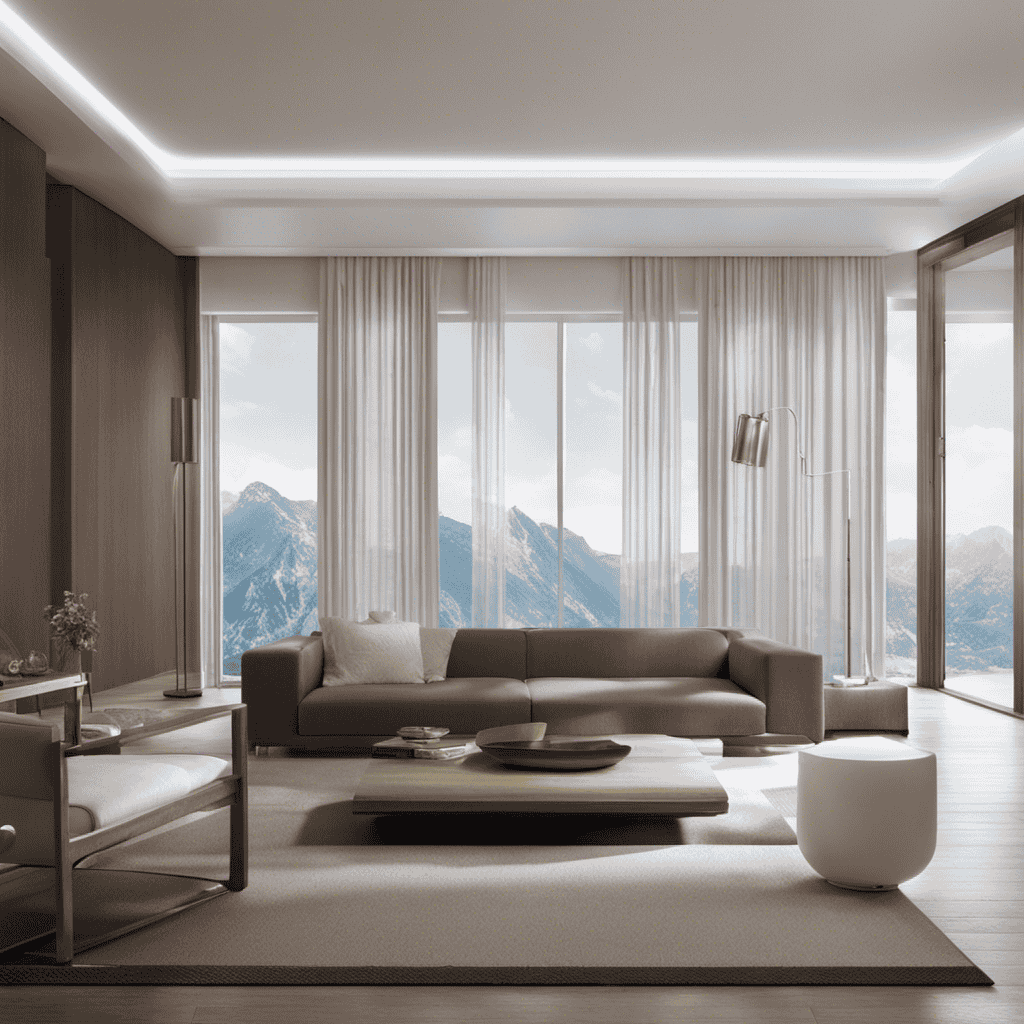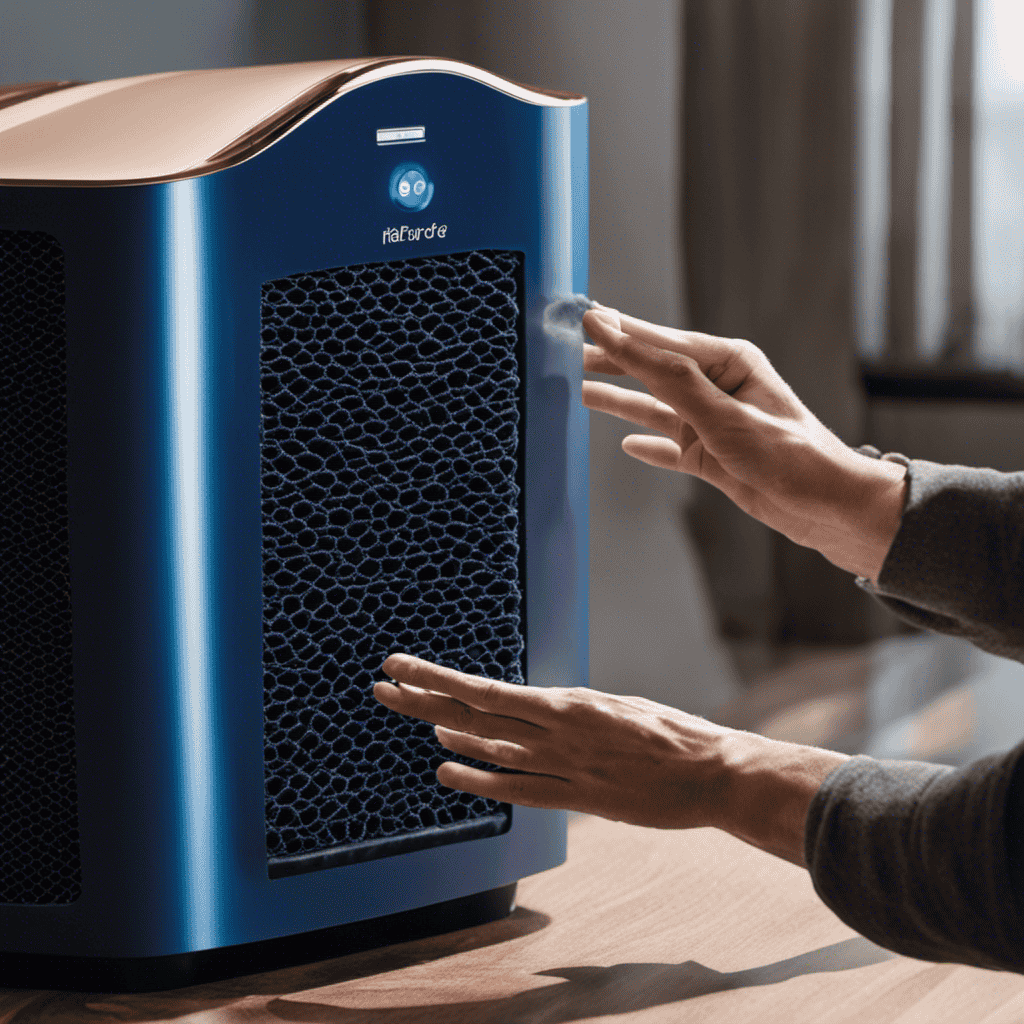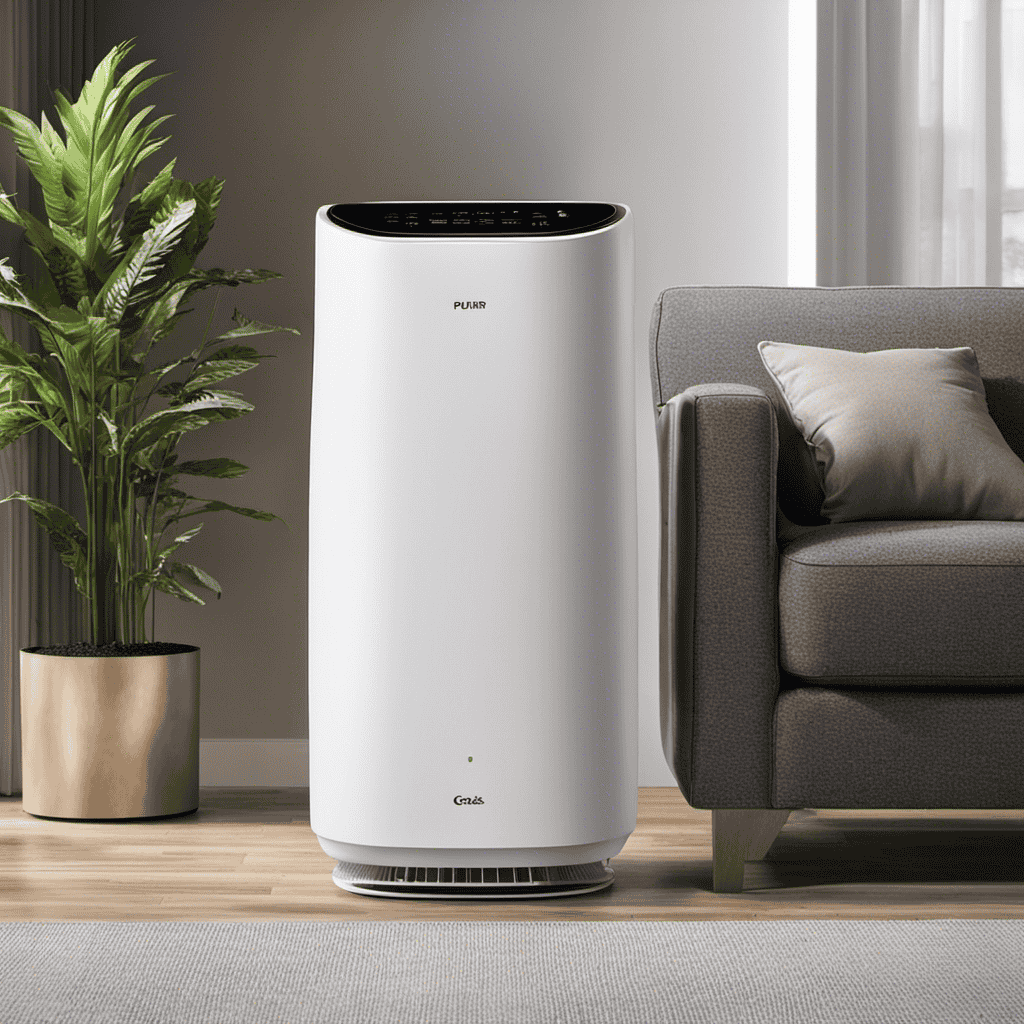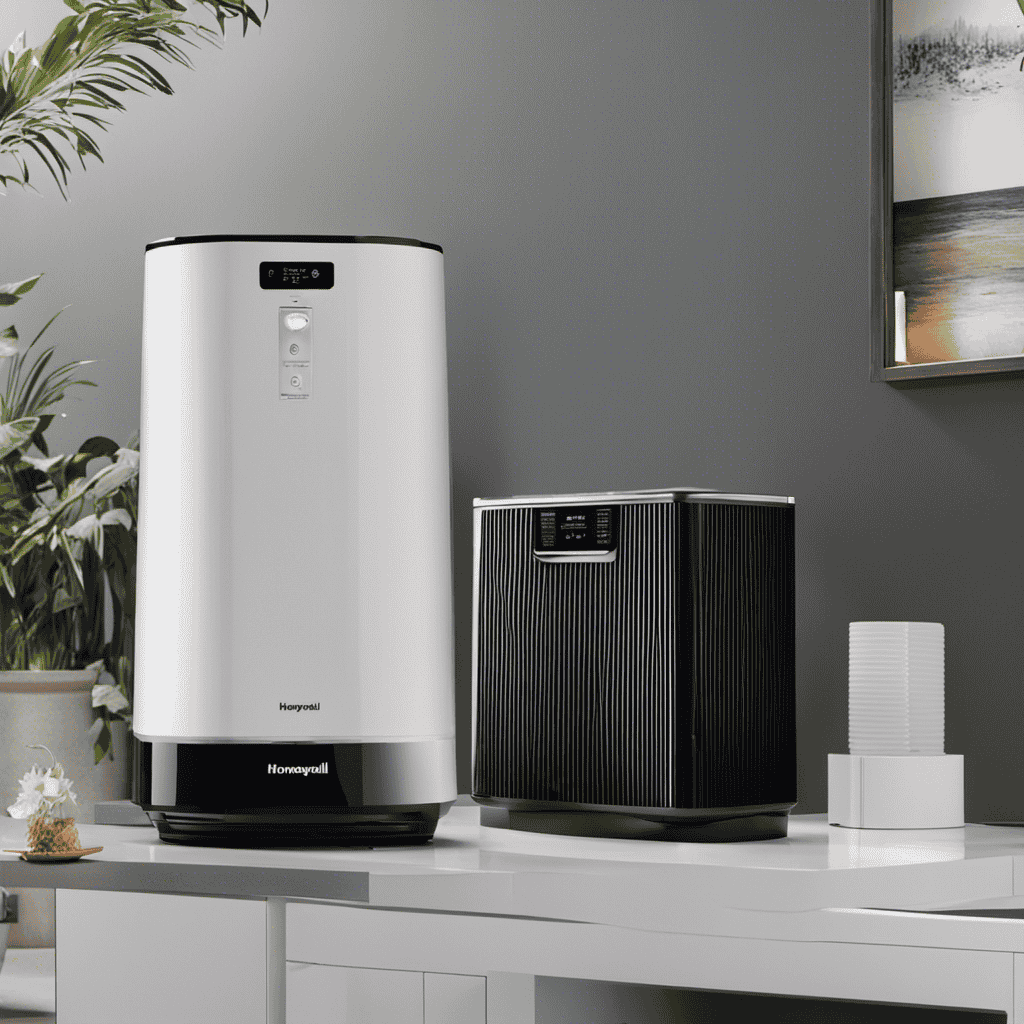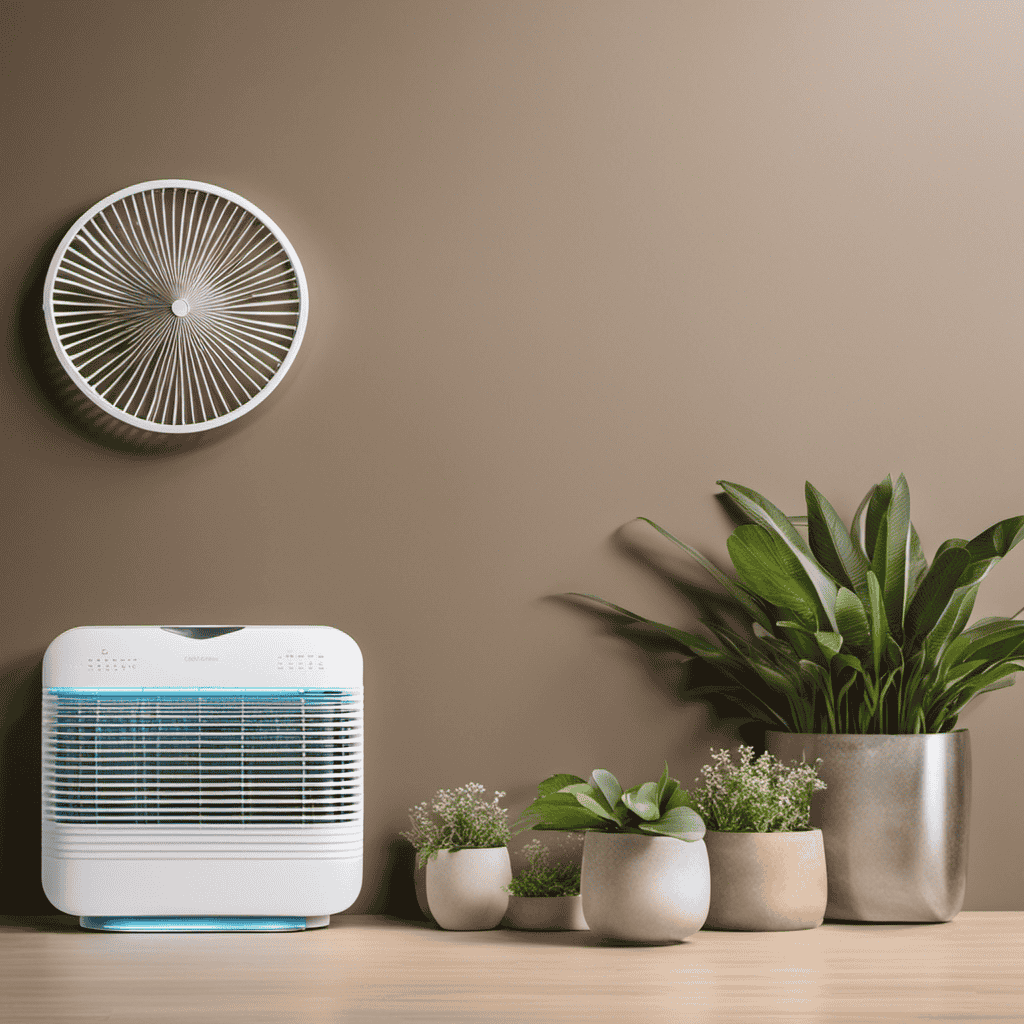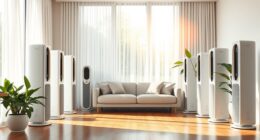As a researcher specializing in indoor air quality, I have frequently contemplated the inquiry: How much time is needed for an air purifier to thoroughly cleanse a room?
With countless air purifiers flooding the market, it’s essential to understand the factors that influence their cleaning time.
In this article, we will delve into the size of the room, air quality levels, the type of technology used, and other crucial variables that impact the time it takes for an air purifier to make a noticeable improvement in your indoor environment.
Key Takeaways
- The size of the room and the air purifier’s coverage area are important factors in determining the cleaning time. Larger rooms may require more powerful air purifiers or multiple units.
- The effectiveness of the air purifier also affects the cleaning time. Higher quality air purifiers clean the room more quickly and effectively.
- The air quality level and the initial pollutant concentration in the room impact the cleaning time. Higher pollutant levels and larger rooms may require higher capacity air purifiers or longer operating time.
- The type of air purifier technology used is also a factor. Different technologies, such as HEPA filters, activated carbon filters, and ionizers, have varying effectiveness in removing different types of pollutants.
Factors Affecting Air Purifier Cleaning Time
There are several factors that can affect how long it takes an air purifier to clean a room.
One of the key factors is the size of the room. Larger rooms will typically take more time to clean compared to smaller rooms. This is because the air purifier needs to circulate and filter a larger volume of air in order to effectively remove pollutants and improve air quality.
Another factor that can impact cleaning time is the effectiveness of the air purifier itself. Different air purifiers have varying levels of efficiency and filtration capabilities. Higher quality air purifiers with advanced filters will generally clean the room more quickly and effectively compared to lower quality models.
Therefore, when considering the cleaning time of an air purifier, it is important to take into account both the size of the room and the effectiveness of the air purifier.
Size of the Room and Air Purifier’s Coverage Area
The size of the room and the coverage area of the air purifier determine how quickly it can freshen the air. The room size implications are significant when it comes to the effectiveness of an air purifier. A larger room requires a more powerful air purifier or multiple units to achieve the same level of purification as a smaller room. The coverage area of an air purifier is the maximum space it can effectively clean. It is crucial to match the purifier’s coverage area with the room size for optimal performance. The table below illustrates the relationship between room size and air purifier effectiveness:
| Room Size | Recommended Air Purifier Coverage Area |
|---|---|
| Small | Up to 200 square feet |
| Medium | 200-400 square feet |
| Large | 400-800 square feet |
| Extra Large | Over 800 square feet |
Understanding the room size implications and selecting an air purifier with an appropriate coverage area is essential to ensure efficient air purification. This leads to the next section, which discusses the impact of air quality level and initial pollutant concentration on the cleaning time.
Air Quality Level and Initial Pollutant Concentration
To effectively freshen the air in your room, consider the level of air quality and the concentration of pollutants at the start. These factors have room size implications and play a crucial role in determining the effectiveness of an air purifier.
The size of the room directly affects the time it takes for an air purifier to clean the air completely. A larger room will require a higher capacity air purifier or a longer operating time to achieve the same level of air quality as a smaller room.
Additionally, the initial concentration of pollutants in the room will also impact the purifying process. Higher pollutant levels will require more time for the air purifier to effectively remove them.
Therefore, when choosing an air purifier, it is important to consider both room size and initial pollutant concentration to ensure optimal performance.
Type of Air Purifier Technology Used
When choosing an air purifier, it’s important to consider the type of technology used for optimal performance.
Air purifiers use various filtration methods to remove contaminants from the air, such as HEPA filters, activated carbon filters, and ionizers. Each technology has its own effectiveness in capturing different types of pollutants.
HEPA filters are highly efficient in removing small particles like dust, pollen, and pet dander. Activated carbon filters are effective in eliminating odors and volatile organic compounds. Ionizers work by charging particles in the air, causing them to stick to surfaces or be attracted to the air purifier’s collection plates.
Understanding the effectiveness of different air purifier technologies can help in choosing the right one for specific air quality needs.
Now, let’s explore the importance of CADR (Clean Air Delivery Rate) and ACH (Air Changes Per Hour) in determining the efficiency of an air purifier.
CADR (Clean Air Delivery Rate) and ACH (Air Changes per Hour
Understanding CADR and ACH is crucial in determining how efficiently an air purifier can improve indoor air quality. These two metrics provide valuable information about the performance of an air purifier and its ability to clean the air in a given space. Here are three key points to consider:
-
CADR measures the amount of clean air that an air purifier can deliver per minute. It indicates how quickly the purifier can remove airborne pollutants, such as dust, pollen, and smoke, from a room. A higher CADR value means the purifier can clean the air faster, making it more effective for larger rooms.
-
ACH refers to the number of times an air purifier can exchange the air in a room within an hour. The higher the ACH, the more times the air is filtered and refreshed. This is particularly important for spaces with high pollution levels or for individuals with respiratory issues.
-
When considering room size implications, it’s essential to match the CADR and ACH values of an air purifier to the size of the room. A purifier with a low CADR or ACH may not be able to effectively clean the air in a larger room, while a high CADR and ACH may be unnecessary for a smaller space.
Air Purifier Fan Speed and Power
When it comes to air purifiers, the effectiveness of the fan speed plays a crucial role in its performance.
In this discussion, we will analyze the impact of fan speed on the overall effectiveness of an air purifier.
Additionally, we will examine the power consumption of various fan speeds to determine the most efficient option.
To provide an objective analysis, we will approach this topic from a scientific and analytical perspective.
Fan Speed Effectiveness
The higher the fan speed, the more effective an air purifier is at cleaning a room. Fan speed optimization plays a crucial role in enhancing the performance of an air purifier. Here are three key factors that contribute to the effectiveness of an air purifier’s fan speed:
-
Airflow direction: An air purifier with adjustable vents and a multi-directional airflow design can effectively circulate and clean the air in all corners of a room. This ensures that even the hard-to-reach areas are purified.
-
Filter efficiency: Higher fan speeds allow air purifiers to push more air through their filters, increasing the rate at which pollutants are captured and removed from the air. Efficient filters, combined with higher fan speeds, can significantly improve the overall cleaning performance.
-
Room size: The fan speed should be adjusted based on the size of the room. A larger room may require a higher fan speed to ensure proper air circulation and purification.
Power Consumption Analysis
To analyze power consumption, you can compare the energy usage of different air purifiers at varying fan speeds. Power consumption analysis is crucial in understanding the impact of air purifiers on electricity bills. By examining the energy usage of various models, we can determine which ones are more energy-efficient and cost-effective in the long run.
It is important to consider both the power consumption of the air purifier itself and the additional electricity needed to operate it at different fan speeds. This analysis allows consumers to make informed decisions based on their budget and environmental concerns.
Understanding the power consumption of air purifiers is just one aspect of evaluating their overall efficiency. Another important factor to consider is maintenance and filter replacement, which I will discuss in the following section.
Maintenance and Filter Replacement
You should regularly replace the filters in your air purifier to maintain its effectiveness. The maintenance cost of an air purifier can vary depending on the type and brand, but one thing is certain: filter replacement is an important aspect of upkeep.
Here are three key factors to consider regarding the lifespan of air purifier filters:
-
Filter Type: Different air purifiers use different types of filters, such as HEPA, activated carbon, or electrostatic filters. Each filter type has a specific lifespan, which can range from a few months to a year or more.
-
Room Conditions: The lifespan of a filter can be affected by the air quality and pollution levels in the room. If you live in an area with high levels of pollutants or have pets, the filter may need to be replaced more frequently.
-
Filter Maintenance: Regular cleaning and maintenance of the filters can help extend their lifespan. Vacuuming or washing reusable filters can remove dust and debris and improve their effectiveness.
Room Layout and Air Circulation
In addition to regular maintenance and filter replacement, another factor that can affect the efficiency of an air purifier is the room layout and furniture arrangement.
Airflow patterns within a room can be influenced by the placement of furniture and other objects, which can impact the distribution of pollutants and the effectiveness of the air purifier.
It is important to consider the airflow patterns when positioning the air purifier and arranging the furniture in the room.
Placing the air purifier in a location with unobstructed airflow, such as near a doorway or in the center of the room, can help ensure optimal circulation and filtration of the air.
Additionally, arranging furniture in a way that promotes good airflow and avoids blocking the purifier’s intake and output vents can further enhance its performance.
Environmental Conditions and Outdoor Pollution Levels
When examining the impact of environmental conditions on outdoor pollution levels, several key points come to mind.
First, humidity plays a crucial role in air quality. High humidity can lead to the formation of pollutants such as ozone and particulate matter.
Second, the time of day also has a significant impact. Pollution levels typically are higher during morning and evening rush hours due to increased vehicle emissions.
Lastly, seasonal variations in pollution levels should not be overlooked. Factors such as temperature inversions and increased use of heating and cooling systems can contribute to higher pollution levels during certain times of the year.
Humidity and Air Quality
The humidity in the room affects the overall air quality. High humidity levels can lead to the growth of mold and mildew, which can release spores into the air and cause respiratory issues. Additionally, high humidity can create a breeding ground for dust mites, another common indoor allergen.
Maintaining a comfortable room temperature and humidity level is crucial for improving air quality and reducing the presence of indoor pollutants. Here are three important factors to consider:
-
Relative humidity: Ideally, indoor humidity should be kept between 30% and 50% to prevent the growth of mold and reduce dust mite populations.
-
Ventilation: Proper ventilation helps to circulate fresh air and remove pollutants, such as volatile organic compounds (VOCs) emitted by household products.
-
Dehumidification: Using a dehumidifier can help regulate humidity levels, especially in areas prone to high humidity, such as basements or bathrooms.
Time of Day Impact
In addition to humidity and air quality, the time of day can also have an impact on the effectiveness of an air purifier. During certain periods, such as early morning or late evening, the air tends to be cooler and more stable. This can create favorable conditions for air purifiers to efficiently filter and clean the air.
On the other hand, during hot and sunny afternoons, the air can become more stagnant and polluted, making it harder for air purifiers to effectively remove contaminants. Similarly, weather conditions such as heavy rain or high winds can also affect the performance of air purifiers. Rain can help to wash away pollutants, while strong winds may introduce more pollutants into the air.
Therefore, considering the time of day and weather conditions is crucial when determining the optimal usage of an air purifier.
Seasonal Variations in Pollution
During certain seasons, like summer or winter, pollution levels tend to be higher, which can affect the performance of air purifiers. Seasonal pollution patterns have a significant impact on the effectiveness of these devices in improving indoor air quality and promoting respiratory health. Here are three important points to consider:
-
Increased outdoor pollution: During certain seasons, such as summer, there may be higher levels of pollutants like smog or pollen in the air. This can lead to increased indoor pollution, which air purifiers must work harder to filter out.
-
Changes in air circulation: Seasonal variations can affect air circulation patterns within buildings. This can impact the distribution of pollutants and the effectiveness of air purifiers in removing them from the air.
-
Allergens and respiratory irritants: Seasonal allergies and respiratory irritants like dust mites or mold spores can be more prevalent during specific times of the year. Air purifiers can help remove these allergens and improve respiratory health.
Understanding the impact of seasonal pollution patterns on air purifiers is crucial for optimizing their performance and ensuring the well-being of individuals.
Transitioning to the subsequent section, let’s explore the impact of activities and occupancy on air purification.
Impact of Activities and Occupancy on Air Purification
Activities and occupancy can affect how long it takes for an air purifier to clean a room. The impact of ventilation on air purification is an important factor to consider. Proper ventilation allows for the exchange of indoor and outdoor air, which helps in removing pollutants from the room.
When activities such as cooking, smoking, or using chemicals occur, the air quality can deteriorate, requiring more time for the air purifier to clean the room effectively.
Additionally, the placement of the air purifier also plays a crucial role in its effectiveness. Placing the unit in a central location ensures better air circulation and coverage, resulting in quicker purification. On the other hand, placing the air purifier near a wall or furniture obstructs the airflow and reduces its efficiency.
Therefore, considering ventilation and appropriate placement are essential for optimizing the air purification process.
Effectiveness of Air Purifier for Different Pollutants
When it comes to different pollutants, an air purifier is effective in removing a variety of them from your indoor environment. The effectiveness of an air purifier depends on its ability to capture and filter out pollutants, such as allergens and pet dander.
Here are three reasons why an air purifier is effective in addressing these issues:
-
Allergies: Air purifiers are designed to remove airborne allergens, such as pollen, dust mites, and mold spores. They use filters to trap these particles, preventing them from circulating in the air and triggering allergic reactions.
-
Pet dander: Air purifiers can also help with pet allergies by capturing and reducing pet dander in the air. Dander, which consists of tiny skin flakes and proteins, can trigger allergic reactions in sensitive individuals. An air purifier with a HEPA filter is particularly effective at capturing these particles.
-
Odor control: In addition to removing allergens, air purifiers can help eliminate unpleasant odors caused by pets. They use activated carbon filters to absorb and neutralize odor-causing molecules, leaving your indoor environment smelling fresh and clean.
Overall, an air purifier is a valuable tool for improving indoor air quality and reducing the impact of allergies and pet dander.
Time Required to Achieve Noticeable Air Quality Improvement
When it comes to air purification, several factors can affect the time required to achieve noticeable air quality improvement. Factors such as the size of the room, the level of pollution, and the efficiency of the air purifier all play a role in determining the purification time.
Additionally, the size of the room can have implications on the effectiveness of the air purifier, as larger rooms may require more time for the purifier to clean the air effectively.
Therefore, understanding these factors and their interplay can help in choosing the right air purifier and setting realistic expectations regarding purification time.
Factors Affecting Purification Time
To determine how long an air purifier takes to clean a room, you should consider factors such as room size, air quality, and the purifier’s specifications. These factors play a crucial role in the purification process and can significantly impact the time required for optimal results.
-
Room size implications: The size of the room directly affects the air purifier’s performance. Larger rooms may require a more powerful purifier or a longer operating time to effectively clean the air.
-
Air quality: The initial air quality in the room can also influence the time needed for purification. If the air is severely polluted, it may take longer for the purifier to remove the contaminants and improve the overall air quality.
-
Continuous operation benefits: Running the air purifier continuously offers several benefits. Continuous operation ensures a consistent flow of purified air, reducing the time needed to achieve clean air. Additionally, continuous operation prevents the buildup of pollutants and maintains a healthier environment throughout the day.
Considering these factors will help you estimate the time required for an air purifier to effectively clean a room and provide you with cleaner, fresher air.
Room Size Implications
In considering the factors that affect the purification time of an air purifier, one important aspect to take into account is the size of the room. Room size limitations can have a significant impact on the effectiveness of an air purifier.
A larger room will require a more powerful air purifier to effectively clean the air. On the other hand, a smaller room may be adequately serviced by a smaller, less powerful unit.
Additionally, the placement of furniture within the room can also affect the purification process. Furniture can obstruct the flow of air and create pockets where pollutants can accumulate, reducing the overall effectiveness of the air purifier.
Therefore, it is important to consider both room size limitations and furniture placement when selecting and positioning an air purifier for optimal performance.
Air Purifier Effectiveness
You can maximize the effectiveness of your air purifier by considering factors such as room size and furniture placement. To ensure optimal air purifier performance and reap the many benefits it offers, here are three key considerations:
-
Room Size: Choose an air purifier with the appropriate coverage for your room size. A larger room will require a more powerful purifier to effectively clean the air. Take measurements of your room and refer to the manufacturer’s guidelines to select the right purifier size.
-
Air Exchange Rate: Look for an air purifier with a high air exchange rate. This measures how many times the purifier can circulate and clean the air in a room in an hour. Higher air exchange rates result in faster and more thorough cleaning.
-
Filter Quality: Pay attention to the type and quality of filters used in the air purifier. HEPA (High-Efficiency Particulate Air) filters are highly effective at removing airborne particles, while activated carbon filters help eliminate odors and harmful gases.
Continuous Operation Vs. Scheduled Usage of Air Purifier
If you want to maximize the effectiveness of your air purifier, consider using it continuously rather than on a schedule.
When it comes to scheduled usage benefits, the main advantage is energy consumption analysis. By using your air purifier on a schedule, you can track the energy consumption and adjust accordingly to conserve energy.
However, when it comes to the overall effectiveness of the air purifier, continuous operation is more beneficial. The continuous operation ensures that the air is constantly being purified, eliminating pollutants and allergens in real-time. This is especially important for individuals with allergies or respiratory conditions.
By running the air purifier continuously, you can maintain a cleaner and healthier environment with minimal interruptions.
Noise Level and Sleep Mode Features
When it comes to air purifiers, considering sleep quality and energy consumption is important. Here are three key factors to consider in relation to noise level and sleep mode features:
-
Noise level: A noisy air purifier can disrupt sleep and affect sleep quality. Look for models that operate quietly, especially if you plan to use them in bedrooms or other areas where silence is important.
-
Sleep mode: Some air purifiers come with a sleep mode feature that operates the unit at a lower fan speed and reduces noise levels. This mode is designed to provide a more peaceful sleeping environment while still maintaining air purification effectiveness.
-
Energy consumption: Air purifiers can consume a significant amount of energy, especially if left running continuously. Look for models with energy-saving features, such as timers or sensors that automatically adjust the fan speed based on air quality, to help reduce energy usage.
Considering these factors will help you choose an air purifier that promotes better sleep quality while minimizing energy consumption.
Now, let’s explore monitoring and feedback systems for air quality improvement.
Monitoring and Feedback Systems for Air Quality Improvement
Monitoring and feedback systems provide real-time data on the quality of the air, allowing users to make informed decisions about their environment. These systems utilize various monitoring techniques to measure pollutants, humidity levels, and temperature. With the advancement of technology, these systems can now be integrated into smart homes, providing users with convenience and ease of access to air quality information.
One of the key monitoring techniques used is the use of sensors that detect and measure air pollutants such as particulate matter, volatile organic compounds (VOCs), and carbon dioxide levels. These sensors can be placed in different areas of the home to provide a comprehensive view of the air quality throughout the living space.
Smart home integration allows users to access this real-time data through their smartphones or other smart devices. This enables them to monitor the air quality even when they are not at home, providing peace of mind and the ability to take necessary actions to improve the air quality if needed.
Is the Cleaning Time of an Air Purifier Dependent on the Brand or Model?
The air purifier cleaning time can vary depending on the brand and model. Some models may require cleaning every 2-3 months, while others may need cleaning every 6-12 months. It’s important to follow the manufacturer’s recommendations to maintain the effectiveness of the air purifier.
Frequently Asked Questions
What Are the Different Types of Air Purifier Technologies and How Do They Affect the Cleaning Time?
Different types of air purifier technologies have various pros and cons, which can impact the cleaning time. It is important to consider the energy consumption of each technology to ensure efficiency.
How Does the Size of the Room and the Air Purifier’s Coverage Area Impact the Time It Takes to Clean the Air?
In determining how the size of a room impacts the effectiveness of an air purifier, it is crucial to consider optimal placement. Ensuring proper coverage and circulation can significantly impact the time it takes to clean the air.
Can the Air Purifier Effectively Clean the Air From Different Types of Pollutants?
The effectiveness of air purifiers for removing allergens and odors can vary depending on the type of pollutants present. Factors such as the filtration system and airflow rate play a crucial role in determining their efficiency in cleaning the air.
How Long Does It Take for an Air Purifier to Noticeably Improve the Air Quality in a Room?
It takes time for an air purifier to noticeably improve room air quality. Factors such as room size, air purifier capacity, and pollutant levels determine the duration. Tips for maximizing effectiveness include choosing the right purifier and regular maintenance.
Is It Better to Run the Air Purifier Continuously or Use It on a Schedule?
Using an air purifier continuously may provide a more consistent clean air environment, but it will consume more energy. On the other hand, using it on a schedule can save energy, but may result in fluctuating air quality.
Conclusion
In conclusion, the time it takes for an air purifier to clean a room depends on various factors. These include the size of the room, air quality level, type of technology used, and the air purifier’s coverage area. The CADR and ACH also play a crucial role in determining the efficiency of the air purifier. Additionally, continuous operation or scheduled usage can affect the cleaning time. It is important to consider these factors when choosing an air purifier to ensure noticeable air quality improvement. As they say, "A breath of fresh air is worth its weight in gold."

